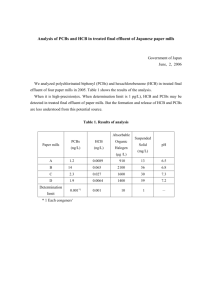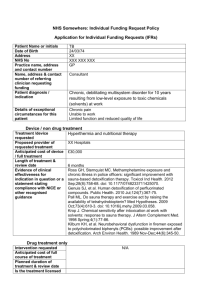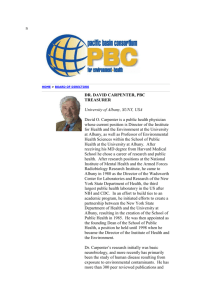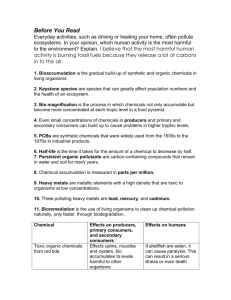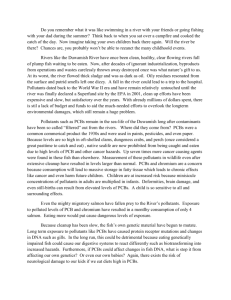THE STANDARD ENTHALPY AND ENTROPY OF FORMATION OF
advertisement
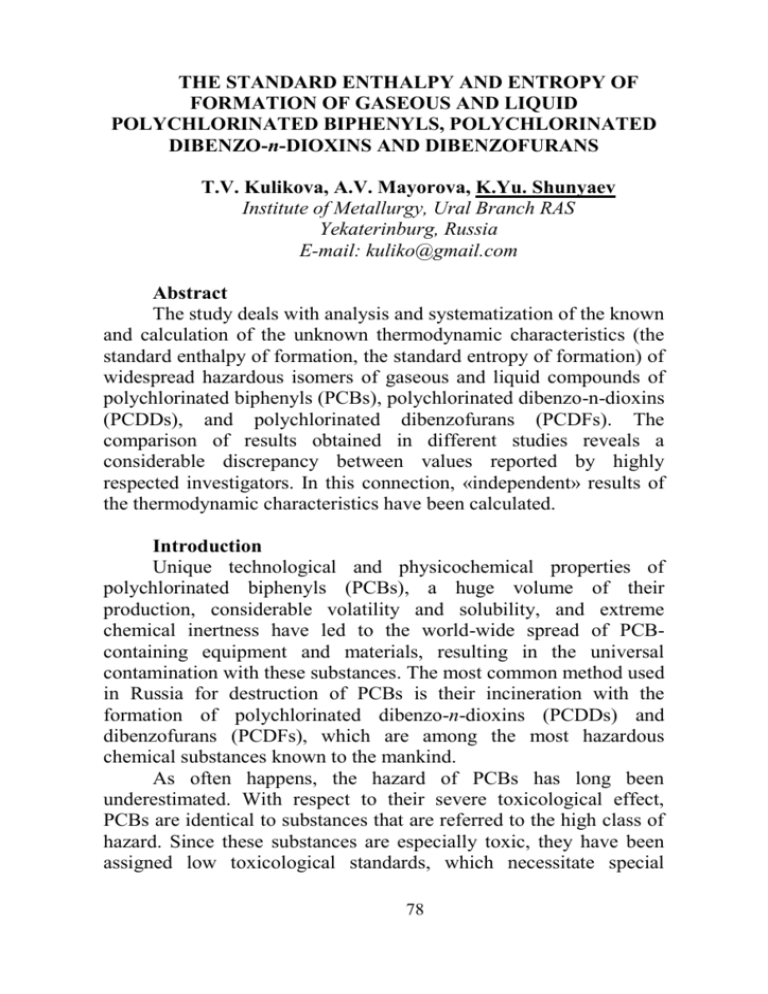
THE STANDARD ENTHALPY AND ENTROPY OF FORMATION OF GASEOUS AND LIQUID POLYCHLORINATED BIPHENYLS, POLYCHLORINATED DIBENZO-n-DIOXINS AND DIBENZOFURANS T.V. Kulikova, A.V. Mayorova, K.Yu. Shunyaev Institute of Metallurgy, Ural Branch RAS Yekaterinburg, Russia E-mail: kuliko@gmail.com Abstract The study deals with analysis and systematization of the known and calculation of the unknown thermodynamic characteristics (the standard enthalpy of formation, the standard entropy of formation) of widespread hazardous isomers of gaseous and liquid compounds of polychlorinated biphenyls (PCBs), polychlorinated dibenzo-n-dioxins (PCDDs), and polychlorinated dibenzofurans (PCDFs). The comparison of results obtained in different studies reveals a considerable discrepancy between values reported by highly respected investigators. In this connection, «independent» results of the thermodynamic characteristics have been calculated. Introduction Unique technological and physicochemical properties of polychlorinated biphenyls (PCBs), a huge volume of their production, considerable volatility and solubility, and extreme chemical inertness have led to the world-wide spread of PCBcontaining equipment and materials, resulting in the universal contamination with these substances. The most common method used in Russia for destruction of PCBs is their incineration with the formation of polychlorinated dibenzo-n-dioxins (PCDDs) and dibenzofurans (PCDFs), which are among the most hazardous chemical substances known to the mankind. As often happens, the hazard of PCBs has long been underestimated. With respect to their severe toxicological effect, PCBs are identical to substances that are referred to the high class of hazard. Since these substances are especially toxic, they have been assigned low toxicological standards, which necessitate special 78 requirements on the organization of processes assuming formation of these substances (the so-called dioxinogenic processes) so that industrial emissions meet the norms. Instrumental investigations of these substances are very expensive and, in this connection, interest is attracted to calculation methods for simulation of processes by the data on their thermochemical properties. A quality thermodynamic simulation requires the knowledge of thermodynamic and thermochemical properties of all reliably certified compounds of the system under study in the gaseous or condensed state. Therefore the present study deals with the analysis and systematization of the known and calculation of the unknown thermochemical properties (the standard enthalpy and entropy of formation) of most toxic and hazardous isomers of gaseous PCBs, PCDDs and PCDFs, and liquid PCBs. Calculation of thermochemical properties It is known that there are 209 individual PCB congeners, 420 polychlorinated dibenzo-n-dioxins and polychlorinated dibenzofurans, which differ by the number and positions of chlorine atoms in a molecule. The most widespread PCB compounds containing up1 to 10 chlorine atoms were chosen for the study. In deciding on isomers, preference was given to ortho-unsubstituted PCBs because they are most toxic and their effect is similar to the effect of PCDDs and PCDFs. Congeners, which do not have chlorine atoms in ortho-positions of molecules (ortho-unsubstituted PCBs), can acquire the planar configuration, which is more favorable in energy terms. Such congeners are isostereoisomeric to PCDDs and PCDFs and present the greatest hazard. As to the PCDD and PCDF isomers, of special hazard to humans and the environment are tri-, tetra-, penta-, and hexa-substituted dioxins and furans containing halogen atoms in lateral positions 2, 3, 7, and 8. In this study we analyzed the known and calculated the unknown thermodynamic properties of 17 most widespread and hazardous isomers of PCBs, PCDDs and PCDFs in the gaseous state and 11 compounds of liquid PCBs. 79 Gaseous PCBs, PCDDs and PCDFs The literature survey showed that studies dealing with estimation of the thermochemical properties of gaseous PCB, PCDD and PCDF compounds are few. Most of them are based on calculations or are semi-empirical. For example, Saito and Fuwa [1] calculated thermodynamic functions of all PCBs and some PCDDs and PCDFs on the basis of semi-empirical calculations in terms of the PM3 model. O.V. Dorofeeva et al. [2-4] used statistical methods. Table 1 presents the literature data on standard enthalpies and entropies of formation of gaseous and liquid PCBs, PCDDs and PCDFs. The comparison of results obtained in different studies reveals a considerable discrepancy between values reported by highly respected investigators who did very arduous work. In particular, values of the formation enthalpy [1] are 8-70% larger and the entropy is 11-15% smaller than the corresponding values in [2-4]; the discrepancy grows with the number of chlorine atoms in a molecule. So, we thought it reasonable and topical to attempt an independent result. Benson's method [5] was used to calculate thermodynamic characteristics (the standard enthalpy of formation ΔН°298, the standard entropy of formation ΔS°298) of the gaseous PCBs, PCDDs and PCDFs. We shall dwell briefly on this method Benson's method is the group additivity method involving analysis of the molecule structure. Atomic or molecular groups are separated and the nearest neighbors of the atom or the group are considered. Table 2 gives the number of groups necessary for determination of group increments in structural formulas of PCBs, PCDFs and PCDDs. Values of the thermodynamic characteristics of group increments were determined from available reference and literature data [5, 6]. Information about the energy contribution of each group (see Table 3) and the number of groups was used to calculate thermochemical properties of the PCBs, PCDDs and PCDFs. 80 Table 1. Standard enthalpies (∆Нo298, kJ/mole) and entropies (∆So298, J/mole K) of formation of gaseous and liquid PCBs, PCDDs and PCDFs Gaseous state Compounds 1 Liquid state So298 the ∆Нo298 So298 ∆Нo298 O.V. Dorofeeva et Saito, Fuwa [1], [7, 8, 12, [7,8,10, the given given al. the given work 16,17] 14, 16, 17] work and work [2-4] [8,14] and [14] 2 3 4 5 6 390.8 [3] 181.9 [8] 181.4 [16] 7 8 9 392.7 [16] 117.1 116.2[8] 117.10 [14] 257.40 257.4 [14] C12H10 (biphenyl) 198.6 [1] 179.7 345.4 [1] 410.4 C12H9Cl (3-monochlorbiphenyl) 170.5 [1] 150.0 385.1 [1] 441.3 156.1 [2] 432.3 [2] 154.8 [8] 150.88 [16] 421.4 [16] 76.29 284.0 C12H8Cl2 142.2 (4,4’-dichlor- [1] biphenyl) 120.2 399.2 [1] 472.1 126.0 [2] 451.8 [2] 127.6 [8] 120.04 [16] 449.2 [16] 35.84 310.6 478.0 [16] -4.52 337.2 C12H7Cl3 (3,4,4’trichlorbiphenyl) C12H6Cl4 (3,3’,4,4’tetrachlorbiphenyl) C12H5Cl5 (3,3’,4,4’,5pentachlorbiphenyl 182.0 [3] 119.4 [1] 90.5 424.0 [1] 503.0 104.1 [2] 492.3 [2] 96.9 [1] 60.8 444.4 [1] 533.8 89.9 [2] 521.6 [2] 74.8 [1] 31.0 462.0 [1] 564.7 56.9 [2] 550.2 [2] C12H4Cl6 52.9 (3,3’,4,4’,5, [1] 5’-hexachlor1.3 biphenyl) 461.5 [1] 595.6 31.4 [2] 567.5 [2] C12H3Cl7 (2,3,3’,4,4’5, 40.0 5’-hepta[1] chlor-28.4 biphenyl) 484.2 [1] 626.4 15.2 [2] 100.4 [8] 89.2 [16] 73.2 [8] 58.36 [16] 46.0 [8] 27.52 [16] 506.8 [16] -44.88 363.8 535.6 [16] -85.24 390.4 19.0 [8] -3.32 [16] 564.4 [16] -125.58 417.0 -8.4 [8] -4.16 [16] 607.7 [2] 81 593.2 [16] -165.96 443.6 1 2 C12H2Cl8 (2,2’,3,3’,4, 24.1 4’,5,5’[1] octachlor- -58.1 biphenyl) C12HCl9 (2,2’,3,3’4 8.73 4’,5,5’6[1] nanochlor- -87.8 biphenyl) C12Cl10 (2,2’,3,3’,4, -6.7 4’,5,5’6,6’[1] decachlor- -117.6 biphenyl) C12H8O2 (dibenzo-ndioxin) -40.2 [1] -44.8 3 4 5 6 7 8 9 488.6 [1] 657.3 -9.0[2] 634.2 [2] -35.6 [16] -65.0 [8] 504.8 [1] 688.1 -15.3 [2] 660.7 [2] -62.8 [16] -95.8 [8] 650.8 [8] -246.68 496.8 503.4 [1] 719.0 -24.7 [2] 675.7 [2] -90.1 [16] -126.7 [8] 679.6 [8] -286.04 523.4 396.5 [4] -59.2 [12] -59.2 [7] -55.0 [17] 395.1 [7] 388.0 [17] - - 478.1 [4] -134.5 [7] -158 [17] 513.6 [7] 478.4 [17] 478.1 [10] 478.4 [9] - - -116.2 [7] -196 [17] 553.1 [10] 501.0 [17] - - 376.4 [1] -59.2 [4] 622.0 [8] -206.32 470.2 C12H4Cl4O2 (2,3,7,8,- -137.2 tetrachlor[1] dibenzo-n- -159.2 dioxin) 455.3 [1] С12H3Cl5O2 (1,2,3,7,8- -153.2 pentachlor- [1] dibenzo-n- -190.0 dioxin) 493.1 [1] -190.0 [4] 540.35 [4] -169.1 [1] -216.4 484.1 [1] -219.6 [4] 569.12 [4] -122.4 [7] 575.59 [7] 523.6 [17] - - -184.8 [1] -247.2 500.5 [1] -246.0 [4] 597.89 [4] -119.6 [7] 610.31 [7] 546.2 [17] - - 106.1 [1] 51.8 378.7 [1] 55.3 [4] 375.9 [4] 55.2 [17] 374.4 [17] - - 20.3 [1] -62.5 450.5 [1] -50.0 [4] - - С12H2Cl6O2 (1,2,3,4,7,8hexachlordibenzo-ndioxin) С12HCl7O2 (1,2,3,4,6,7, 8-heptachlordibenzo-ndioxin) C12H8O (dibenzofuran) C12H4Cl4O (1,2,3,4tetrachlordibenzofuran) -164.0 [4] 490.98 [4] -52.8 [17] 82 464.8 [14] 1 2 С12H3Cl5O (1,2,3,7,8- -12.3 pentachlor- [1] dibenzo-93.4 furan) С12H2Cl6O (1,2,3,4,7,8-28.3 hexachlor[1] dibenzo-124.2 furan) С12HCl7O (1,2,3,4,6,7,8 -44.1 heptachlor[1] dibenzo-155.0 furan) 3 459.2 [1] 4 5 6 7 -75.9 [4] 519.75 [4] -74.8 [17] 487.4 [14] 8 9 - - 471.3[1] -105.1 [4] 548.52 [4] -104.3 [17] 510.0 [14] - - 483.3 [1] -131.5 [4] 577.29 [4] -131.3 [17] 532.6 [14] - - Table 2. Number of groups for determination of group increments in structural formulas of PCBs, PCDFs and PVDDs Compound Св*-H PCBs PCDFs PCDDs 10 - n 8-n 8-n Number of groups Св-Cl Св-O Св-Св n n n 2 4 2 2 - Number of chlorine atoms in a molecule (n) 1 – 10 1–8 1–8 Св* is the carbon atom in an aromatic ring. Values presented in Table 1 show the thermodynamic characteristics of PCBs, PCDDs and PCDFs calculated in this study and by other investigators. It is seen, for example, ( Table 1) that the formation enthalpy o ( H 298 ) of biphenyl (C12H10) equals (kJ/mole) 198.6 [1], 182.0 [3], o 181.9 [7], and 181.4 [8], while the formation entropy ( S 298 ) of 2,3,7,8-tetrachlordibenzo-n-dioxin (C12H4Cl4O2) is (J/(mole K)) 455.3 [1], 478.1 [4], 478.4 [9], and 478.1 [10]. 83 Table 3. Values of the thermodynamic characteristics determined by the method of group increments[5,8]. Group Св*-H Св-Св Св-Cl (Св)2-O orto corr Cl-Cl meta corr Cl-Cl (gas) o H 298 , kJ/mole 13,81[8] 13,82[5] 21,66[8] 20,77[13] -17,03[8] -15,91[5] -77,66[8] -88,34[5] 9,50[8] 9,21[5] -5,00[8] S o298 , J/(moleК) 48,31[8] 48,27[5] -36,57[8] -36,18[5] 77,08[8] 79,13[5] - (liquid) o H 298 , S o298 , kJ/mole J/(moleK) 8,16[8] 28,87[8] 17,21[8] - -32,20[8] 55,47[8] - - 14,00[5] - 4,00[5] - In this study the values of the standard entropy of formation obtained by using statistical methods (O.V. Dorofeeva et al. [2-4, 9]) for 17 isomers of PCBs, PCDDs and PCDFs are in good agreement with the values calculated by other investigators [8, 10, 12, 13] and with the values calculated by us. Liquid PCBs It should be noted that ample literature data on the thermochemical properties of liquid ecotoxicants is only available for biphenyl (C12H10) [8, 14], dibenzo-n-dioxin (C12H8O2) [11, 15] and dibenzofuran (C12H8O) [5, 17]. The only study dealing with calculation of thermodynamic functions for the whole series of liquid PCDD and PCDF homologues was published by V.S. Iorish et al. [11]. As to liquid PCB compounds, the literature data on their thermochemical properties are scarce [8, 14]. The thermochemical properties, namely the standard enthalpy and entropy of formation of liquid PCBs were calculated using the group additivity method due to Domalski [8]. Values of the group increments (Table 3) were adopted from [8]. It is seen from Table 3 84 that the energy contribution of the group Св-Св is unavailable for the o entropy calculation. However, if one uses known values of S 298 for liquid biphenyl (C12H10) [14] and the data on the contribution of the o Св-H and Св-Cl groups [8], it is possible to calculate S 298 for the whole series of PCBs: S o298 (PCB) = S o298 (BP) - (10-n) S o298 (Св-H) + n S o298 (Св-Cl) + +(m*orto corr Cl- Cl ) +(p*meta corr Cl- Cl) (1) where n is the number of chlorine atoms in a PCBs molecule, m (p) - spatial amendments, number Cl (from two and more), being in orto - (meta-) position rather each other. o The enthalpy of formation ( H 298 ) for the PCBs series compounds was calculated by two options: using the group additivity method due to Domalski [8] and from the equation H o298 (PCB) = H o298 (BP) - (10 - n) H o298 (Св-H) + o + n H 298 (Св -Cl) +(m*orto corr Cl-Cl )+(p*meta corr Cl-Cl), (2) Table 4 lists values of the standard enthalpy of formation for the series of liquid PCBs compounds as calculated by the group additivity method [8] and the equation (2). It is seen that the values of H o298 , which were calculated by the two methods, are in good mutual agreement. The thermochemical properties, which were taken as reliable, were added to the TERRA database and were used for thermodynamic simulation of the thermal stability of PCBs, PCDDs and PCDFs. 85 Table 4. Calculated enthalpy of formation (∆Нo298) for liquid PCBs compounds. Compound C12H9Cl (3-monochlorbiphenyl) C12H8Cl2 (4,4’-dichlorbiphenyl) C12H7Cl3 (3,4,4’- trichlorbiphenyl) C12H6Cl4 (3,3’,4,4’-tetrachlorbiphenyl) C12H5Cl5 (3,3’,4,4’,5-pentachlorbiphenyl) C12H4Cl6 (3,3’,4,4’,5,5’-hexachlorbiphenyl) C12H3Cl7 (2,3,3’,4,4’,5,5’-heptachlorbiphenyl) C12H2Cl8 (2,2’,3,3’,4,4’,5,5’-octachlorbiphenyl) C12HCl9 (2,2’,3,3’,4,4’,5,5’6-nanochlorbiphenyl) C12Cl10 (2,2’,3,3’,4,4’,5,5’6,6’decachlorbiphenyl) ∆Нo298, kJ/mole Group Eq. (5) increments method 75.84 76.742 δ, % 1.2 35.30 36.382 3.0 -5.06 -3.978 21.38 -45.42 -44.338 2.38 -85.78 -84.698 1.26 -126.1 -125.058 0.83 -166.5 -165.418 0.65 -206.86 -205.778 0.52 -247.22 -246.138 0.44 -287.58 -286.498 0.38 Conclusions 1.The literature data on the thermochemical properties of 17 most widespread and hazardous isomers of PCBs, PCDDs and PCDFs in the gaseous state and 11 compounds of liquid PCBs have been analyzed and systematized for the first time. 2.Methods have been developed for calculating of the thermodynamic characteristics of organic compounds. Values of the thermodynamic functions (standard enthalpy and entropy of formation) of liquid PCBs, PCDDs and PCDFs have been calculated for the first time. 86 3.The comparison of the calculated values of the thermodynamic functions with the known literature data demonstrated their good mutual correlation. 4.The obtained data were added to the TERRA database and were used for thermodynamic simulation of the thermal stability of PCBs, PCDDs and PCDFs. 5.The obtained data can be used for simulating of the behavior of complex heterogeneous systems, including ecotoxicants, over a wide interval of temperatures and initial compositions. This study was supported by RFBR (project No. 08-03-00362-a). References 1. Nagahiro Saito, Akio Fuwa. Chemosphere. 2000, vol.40, p. 131-145. 2. O.V. Dorofeeva, N.F. Moiseeva, V.S. Yungman.L.V., J.Phys. Chem. A., 2004, vol. 108, p. 8324-8332. 3. O.V. Dorofeeva., Thermodynamica Acta.,2001, vol.374., p.7-11. 4. O.V. Dorofeeva, V.S. Iorish, N.F. Moiseeva., J. Chem. Eng. Data., 1999, vol. 44, p. 516-523. 5. S.W. Benson, F.R. Cruickshank, D.M. Golden, G.R. Haugen, H.E. O’Neal, A.S. Rodgers, R. Shaw, and R. Walsh. Chem. Rev., 1969, vol.69, p. 279 -324. 6. H.K. Eigenmann, D.M. Golden, and S.W Benson. J. Phys. Chem., 1973, vol. 77, 1687-1691. 7. Jung Eun Lee and Wonyong Choi., J. Phys.Chem. A, 2003, vol. 107, p. 2693-2699. 8. Domalski E. S. and Hearing E. D., J. of Phys. and Chem. Ref. Data, 1993, vol. 22, p. 805-1159. 9. L.V. Gurvich, O.V. Dorofeeva, V.S. Iorish., Zh. Fiz. Khimii, 1993, vol.67, No. 10, p. 2030-2032. 10. W.-Y. Shiu and K.-C. Ma., J. Chem. Ref. Data, 2000, vol.29, No. 3, p. 387-462. 11. V.S. Iorish, O.V. Dorofeeva, N.F. Moiseeva, J. Chem. Eng. Data., 2001, vol.46, p. 286-298. 12. V.A. Lukyanova, V.P. Kolesov, Zh. Fiz. Khimii.,1997, vol. 71, No. 3, p. 406-408(in Russian). 87 13. P. Reid, J. Prausnitz, T. Sherwood.,Leningrad, Khimiya, 1982, 592 p(in Russian). 14. Richard, Laurent and Helgeson Harold C. Geochimica et Cosmochimica Acta, 1998, vol. 62, No. 23/24, p. 3591 – 3636. 15. I. Barin: “Thermochemical Data of Pure Substances”. Weinheim, Federal Republic of Germany: VCH Verlagsgesellschaft mbH, 1997. 16. "Cambridgesoft" database, ver. 8.0.6, December 31, 2003. 17. Thompson D., Thermochim. Acta, 1995, vol.261, p.7-20. 88

